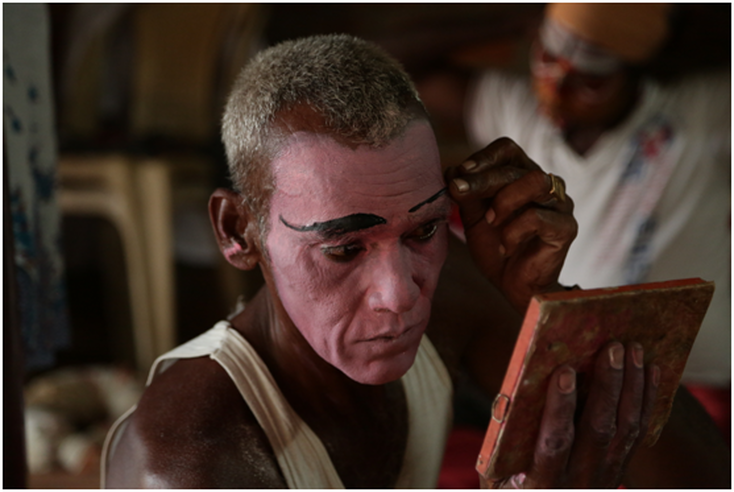|
Our identities are created through an engagement with our world. They are not rigid and hard entities. The mahabhArata is a tale of destruction that ensues when people in power rigidify their identity. One can only feel threatened by reality as it emerges since the ever changing world will only sometimes conform to our needs and expectations of it! One must then defend ones identity with violence and seek to dominate the world and make it conform to our formulation.
One of the explorations that the Immersion offered was the process by which we form our inner selves. We can engage with the world from a fullness within, and when the world welcomes this expression there is an unfolding and love. It can choose to negate the offering and one feels hurt and challenged. Coversely, one can withdraw from all engagement and feel depleted within. The world in its turn could choose to ignore us, and leave us to our own devices in our lonely world. The world can choose to accept our depleted state and offer help. These experiences keep changing but we tend to hold on to one or the other of these experiences as a defining state and build our identities around this assumption. The idea behind asking groups to choose a character they wish to explore and making them explore the whole context that is created equally by the various protagonists is based on this understanding of how one creates dukha by getting entrenched in a few possible ways of being and by holding the others in fear. Shakuni is universally considered to be a villain. The group that chose to explore shakuni ‘inside out’ took a difficult path. It came as no surprise when the group decided to have two people playing each of the three roles namely, shakuni, yudhishtra and duryOdhana! The idea of exploring villainy is daunting. The scene they explored was the one where yudhishtra is enticed to gamble. Yudhishtra struggles with his shadow self. The presentation of always being righteous and playing by the book has been achieved by repressing a part of the self that would like to throw caution to the winds is challenged. yudhishtra has the freedom to say no, but his compulsion gets the better of him. shakuni is an honest broker, he is here to ensure that his sister and her family is not cheated by the scheming kuru clan. When the standard of honour and integrity expected of a great Kingdom is not lived up to, one has to fall back on ones ingenuity. The enactment centered around the encounter between a shakuni employing his wits to survive and proper in a space where there is no real respect for the law, and the law abiding yudhistra battling his own inner demons. The new perspective that was presented gripped the group: shakuni was doing what any one who has seen his sister being illtrated by the in-laws would do! If we remove the idealized picture of world, we see its underbelly, a chaotic place where each one is trying to defend them selves, to survive and hopefully come out on top! In such a world, the trickster’s wits are essential. In all ancient mythologies it is the trickster hero who gets the fire from the gods, and who helps the tribe grow without paying a heavy price. Seen this way, krishNa is a trickster too! The heavy price paid by a socialized mind also became evident. yudhishtra is the arch symbol of the “good son/ good citizen” the price of being called good, of having to control ones impulses and postpone its fulfillment is hidden craving for the forbidden. Also, the group got in touch with the helplessness that assails us when the world around us is not law abiding, and we value honesty. Along with the control we exercise over our impulses, we give up our intuition and animal sensing of danger and of the other persons motives. What happens to us as a nation when the context becomes unpredictable and the rule of law does not operate? We tend to get paralyzed or we fall back on our own resources of power and cunning. The chaos that ensues also releases some of our constraints and our shadow sides play up. A negative spiral starts ending up with a raw use of power, there is fighting and war! We see this in families too.
1 Comment
|
Raghu's BlogMy work revolves around helping individuals, groups and organizations discover their Dhamma, and become “the best they can be”. This aligns with my own personal saadhana. I have restated this question for my self as follows: “how can I be in touch with the well spring of my love for the world and my love for my self simultaneously” Archives
October 2017
Categories |

 RSS Feed
RSS Feed
